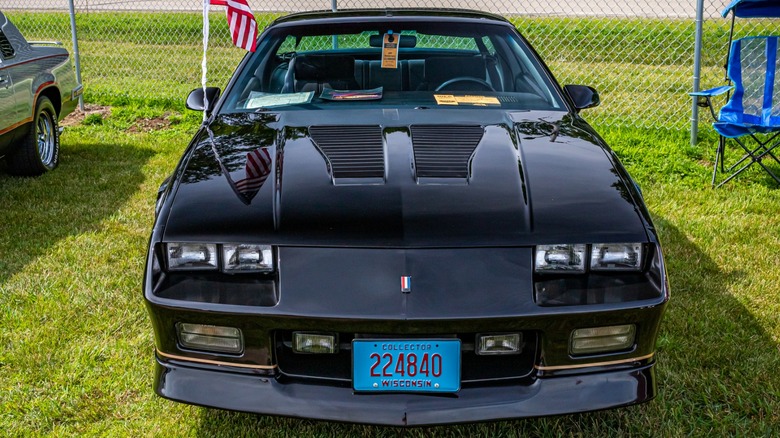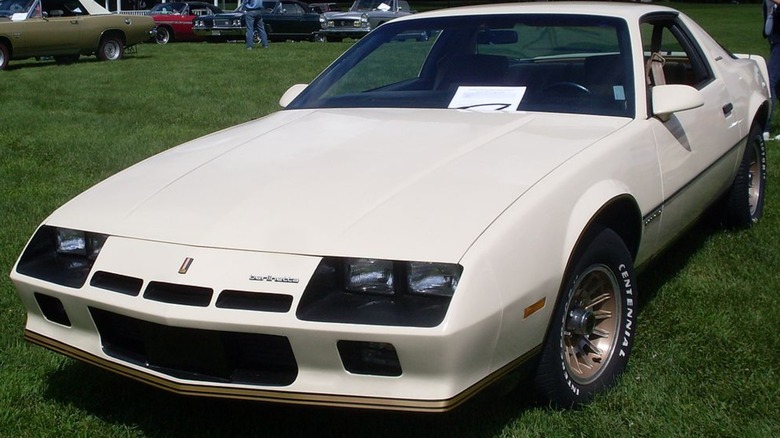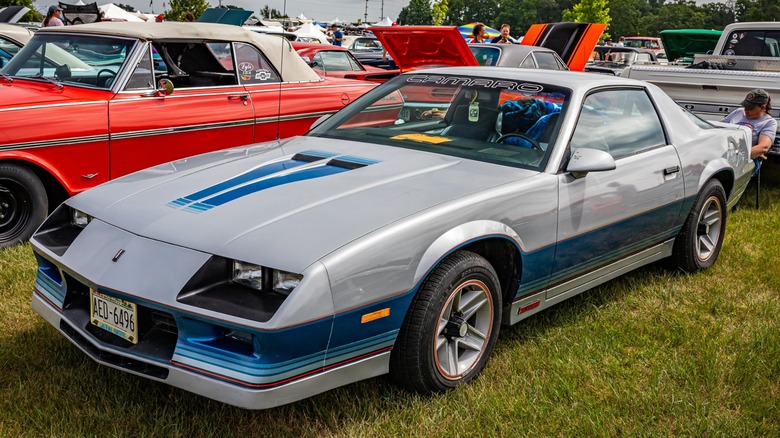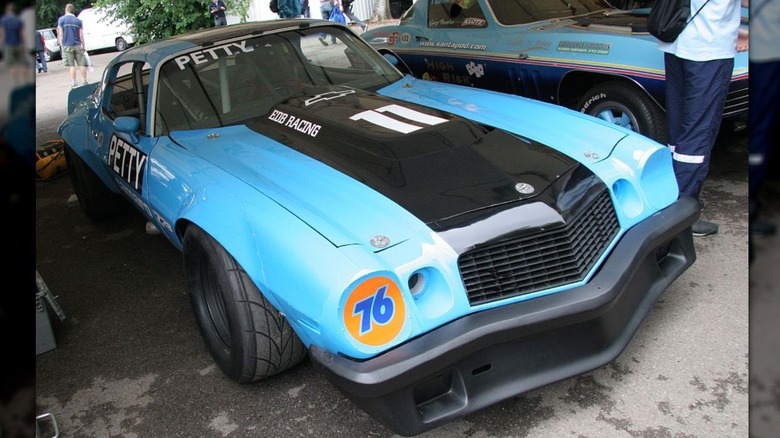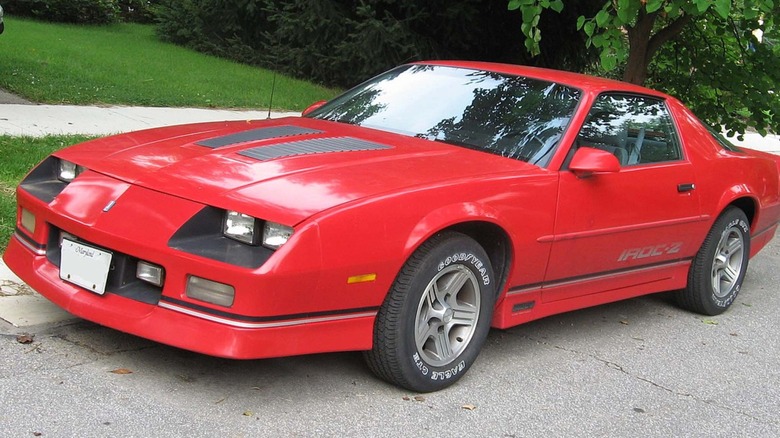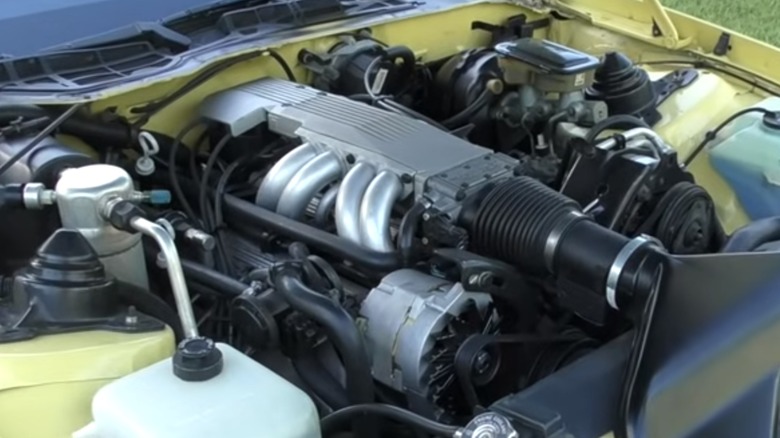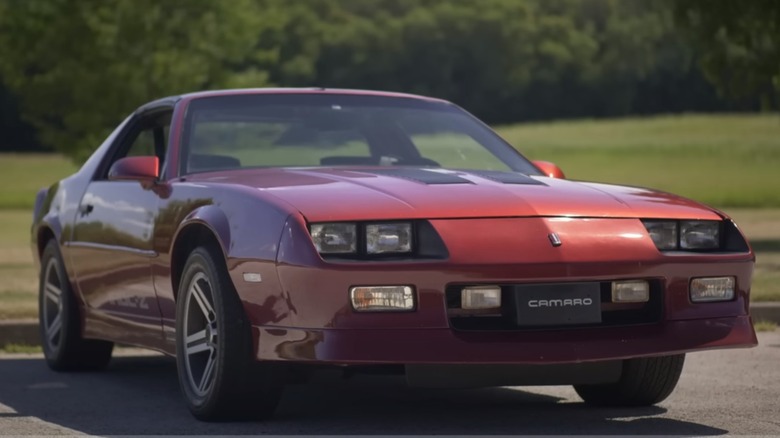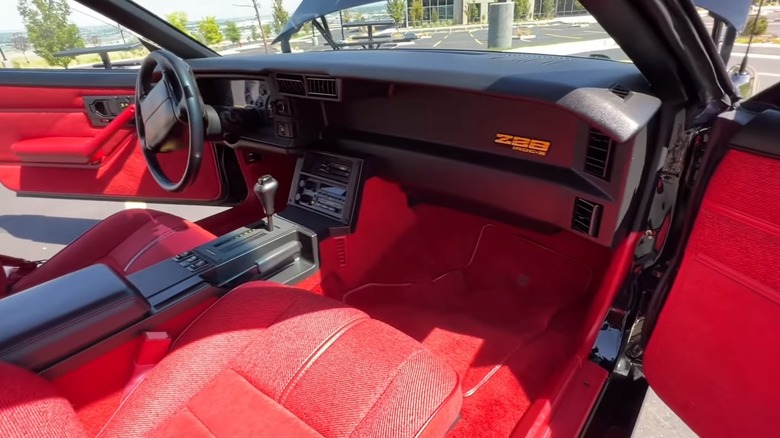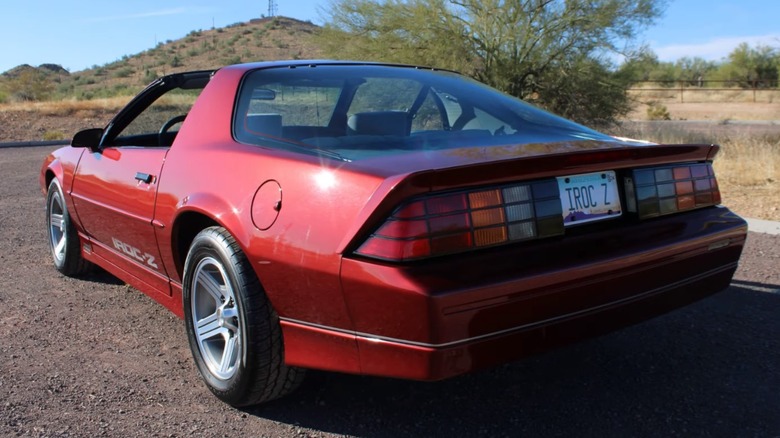A Closer Look At The IROC-Z: Chevy's Standout Camaro
Few things from the 1980s are as cool as the IROC-Z Camaro, a car that came along at a time of expanding technology and huge shoulder pads. Pastel colors were in, but the hippies were out, all while Huey Lewis was on the radio and TV had us all asking "Who's The Boss?" It was during this time that Chevrolet brought us a version of the Camaro that has come to be an iconic symbol of the decade. Car styling was changing, adopting more straight edges and the creeping influence of the Euro look. The Camaro exemplifies all these changes and remains unmistakable to this day.
Throughout the time Chevrolet offered the third-generation Camaro, it was offered with a range of option packages that came with everything from a lowly 4-cylinder –- the infamous Iron Duke –- to the legendary small block Chevy V8. The new car was aerodynamic, sporty, and sleek, with those in the know opting for the IROC-Z Camaro. It was the top-of-the-line Camaro at the time and anyone who showed up in one was certifiably cool. Incidentally, that person had an extremely high chance of having a mullet, so make of that what you will. Haircuts aside, the IROC-Z was a great car then, and it is still a great car today.
Since it has been a while since any of them were found in a Chevrolet showroom, here is a closer look at the IROC-Z — the 1980s epitome of cool.
Third generation Camaro
By 1980, the Camaro body style that had ruled the '70s was getting a bit long in the tooth, so designers at Chevrolet got to work putting together the car that would Camaro that hit the dealer lots in 1982. This new car was a complete departure from the previous model, although it did not get converted to a front-wheel-drive platform as some executives had suggested. The new design was sleek and slippery with a bold new look representing the era through flat panels and sharp creases.
Things had changed very much inside as well. The dashboard was now a long and high shelf across the car with more straight edges and right angles on every surface. The gauge cluster was driver-focused with large and prominent dials, although regulations limited the speedometer to just 85 mph, a hopelessly dated but charming quirk.
Base Camaros received a 4-cylinder with a pitiful 90 horsepower but were still equipped with MacPherson struts up front and coil springs in the rear. Other engine options were a 2.8-liter V6 or a 5.0-liter V8. However, even with the larger engines, the power output was still disappointing. Upon Camaro's introduction, the highest spec model was the Z/28 with a cross-fire injected 5.0 that made just 165 horsepower. While the 4-cylinder also received fuel injection, the other V8 and V6 came with carburetors, although the base model with a V8 still only mustered 145 horsepower.
Thankfully, power and technology steadily increased -– multi-port fuel injection eventually made it to all engine options -– throughout its run until a new car debuted in 1993.
Z/28 Camaro
From the inaugural year of the model, the highest trim level excluding special editions had been the Z/28. This name came from the performance package that would make the car eligible to run in the Trans Am racing series. Buyers who wanted it needed to mark the regular production order code Z28 to receive a unique 302 V8 that fell below the 305 limit for Trans Am. Thus, a high-performance legend was born and the Z/28 designation became the standard bearer for affordable Chevrolet performance.
The Z/28 would remain an option throughout the production run from 1982 to 1987 before being briefly dropped and finally picked up again for the last two years. Initially, It came with a choice of carbureted 5.0-liter V8 or the lackluster Cross-Fire fuel-injected version, and its suspension was upgraded for better handling. It also received a rear spoiler, front air dam, and ground effects, while the hood was treated with air intake scoops, although they were only functional initially on the Cross-Fire versions. The front and rear bumpers were modified specific to the Z/28 and additional appointments found their way inside, such as a clock and tachometer.
Starting in 1985, Chevy upgraded the Z/28 engine with the tuned-port fuel-injection system on the 5.0-liter V8, increasing performance, efficiency, and reliability. The new engine offered 215 horsepower with 275 lb-lb of torque, signaling the return of performance for the model. Furthermore, for the first time, the Z/28 was offered with another higher-spec version — the IROC-Z.
International Race of Champions
Before getting into the details of the IROC-Z, some attention should be paid to where the name came from. The International Race of Champions — or IROC — came from an idea in 1973 to gather a dozen of the best racing drivers in the world to compete. Putting drivers in identical cars on road courses and oval tracks leveled the playing field, leaving driving skill alone to rule the day.
The first year's races began in October 1973, with the Porsche 911 Carrera RSR chosen for all drivers. For the second year of racing, the more affordable Camaro was chosen, and Penske Racing set up the cars for the drivers. Although drivers from multiple racing series were invited to race, most of the early years were dominated by Indy car drivers such as Bobby Unser and A.J. Foyt. Racing ended in 1980 but received a second chance in 1984, now with the third-gen Camaro at the starting line. During the second era of IROC, NASCAR drivers found their footing and dominated the races, winning five of seven championships.
This popular racing series prompted Chevrolet to affix the name to a special edition of the Z/28 in 1985. That name recognition aided with cross-promotion on the track and in the showroom until Chevrolet's sponsorship ended with the close of the 1989 season. Dodge picked up the race in 1990 with its Daytona model — which was replaced by the Dodge Avenger in 1994 — taking the track while the IROC-Z model designation was retired, returning Z/28 to the top position in the Camaro hierarchy.
[Featured image by Brian Snelson via Wikimedia Commons | Cropped and scaled | CC BY 2.0]
IROC-Z specifications
In its debut year, the IROC-Z was offered as a car for those who liked the Z/28 but wanted a bit more and could afford it, which meant that IROC-Z models could be configured with a few different options. The IROC-Z option package was a $696 upgrade to the Z/28 base price that included special 5-spoke wheels, upgraded suspension, as well as a graphics package with ground effects and hood louvers. Engine choices ranged from a carbureted 305 V8, High Output 305 V8, or the tuned port injected (TPI) 305 V8.
The standard engine came with a 5-speed manual or 4-speed automatic while the L69 was paired only to a 5-speed, and the only TPI V8 transmission was automatic. However, 1987 became a good year for IROC-Z buyers as Chevrolet started offering the TPI engine with a manual transmission. Even better was that the legendary TPI 5.7-liter Chevy 350 V8 from the Corvette became an option as well. Although the 5.7 could only be mated to an automatic, the added performance was a welcome option.
By 1988, Chevrolet had dropped the Z/28 name altogether and continued building on the success of the IROC-Z package as a stand-alone model. In 1989, those in the know could order the $2,477 1LE package that added several performance upgrades, making the car essentially race-ready out of the showroom. Eventually, sales dwindled and IROC sponsorship ended, making 1990 its final year.
Tuned-port 350 V8
Adding the TPI 350 as an option was a significant move by Chevrolet and helped to upgrade the stature of the IROC-Z significantly. At the time, Ford's Fox Body Mustang GT — with its High Output 5.0 engine equipped with sequential port fuel injection — was gaining in horsepower and market share. However, the TPI 5.0 engine was running near its output limit given the technology available, and Chevrolet did not want to let Ford pull ahead.
To set the Camaro as far out in front as possible, Chevrolet put the 5.7-liter V8 from the Corvette into the IROC-Z. The fuel-injection system featured sequential fuel injectors with air coming into a plenum and fed to the engine through eight equal-length runners, the tuned ports. This is the system that replaced the problematic Cross-Fire injection and proved to be a robust system that improved efficiency and throttle response, although most of the power came in under 4,400 rpm.
When placed in the IROC-Z, it was equipped with cast iron heads instead of the Corvette's aluminum heads and tuned down a bit to 225 horsepower while adding more than $1,000 to the price of a car already laden with options. The 5.7-liter IROC-Z models also received oil and transmission coolers as well as a Borg-Warner Posi-traction rear end with a 3.27 gearing. This was the highest trim level of Camaro offered at the time and the most power available from a Chevrolet without opting for the Corvette.
IROC-Z performance
While the IROC-Z remains a performance icon of the '80s, many of its performance figures can be a bit disappointing compared to what is available today. In its debut year, the base V8 engine only made 155 horsepower. However, if you opted for the High Output 305, that figure increased to 190. These were both equipped with a Quadrajet carburetor but the fuel-injected TPI 305 increased output to 215 horsepower.
Torque ratings from all three engines look much better in comparison as they were 245, 240, and 275 lb-ft, respectively. The TPI version could hit 145 mph at its top end and reach 60 mph in 7.3 seconds. None of this is impressive now, but compared to the contemporary Corvette, which offered 230 horsepower and 330 lb-ft of torque, you can see it was not far behind the benchmark of the day. By the time the model designation was retired, power had improved nicely. The 5.7-liter offered 245 horsepower with 345 lb-ft of torque, which was plenty for some tire squealing.
However, the best measure of performance is how a car stands up to its competition. In a Motorweek Retro Review, originally aired in 1985, The then-new model IROC-Z goes head-to-head against both the Ford Mustang and Pontiac Firebird Trans Am, all equipped with the highest output engine available at the time. While the IROC had the most horsepower, it surprisingly was the slowest in the drag race. However, when put through a 2-mile road course, its sophisticated suspension shined and the IROC beat both cars by nearly a second with the highest average speed.
Life in an IROC-Z
Looking at the specifications and performance figures of a car can tell you about how fast it is or how well-equipped it is, but these things say nothing about driving one. As someone who has spent much time in third-generation Camaros, including a couple of IROC-Zs, I have plenty of insight.
One thing to consider is that American cars of the '80s generally suffered from poor build quality, especially compared to today's cars. These Camaros looked sharp and even drove pretty nicely, but you would have to get accustomed to squeaks and rattles in the interior, even when they were relatively new. Many of the plastics of the interior fit poorly from the factory and the long and heavy doors sagged something terrible. The equally long, heavy, and frameless windows often sat loose and sealed poorly.
You can generally rely on the engine and other mechanicals, but little things like window cranks and door handles might break -– usually at the worst possible moment. A common phrase used for these cars back in the day referred to them as "fall-apart cars." Nonetheless, driving could be fun and enjoyable with a firm ride while the tight and responsive but overboosted power steering makes the car go in whatever direction you pointed it without question. Also, since nothing at the time had a lot of power, we did not know any better and these cars sure felt fast at the time.
IROC-Z today
Given that the IROC-Z was considered an affordable performance car, lots of them were bought by young people who wanted to go fast and look flashy in the process. As a result, most of them were torn up pretty quickly. Furthermore, few cars at the time made it past 150,000 miles, so most of them went to the salvage yard long ago. This means that third-gen Camaros today can most often be found in one of two conditions — pristine and like-new or completely beyond repair. Some of these IROC-Zs are likely sitting around in such disrepair there is no saving them. The well-preserved examples are another story altogether.
You can find dozens of sold listings for third-gen Camaros on Bring a Trailer, many of them being IROC-Z models. A portion of those have been like-new, with less than a couple of thousand miles on the odometer. In such mint condition, these cars are commanding winning bids in the $60,000 range while those with 5,000 or more miles are still easily more than $40,000. Other exceptionally nice cars with around 20,000 miles can still sell for more than $20,000, and the price lowers with miles and condition from there.
These prices show that the IROC-Z has become a desirable car for collectors. However, there are probably still some bargains for gems in the wild if you look hard enough. No matter what, values are sure to rise across the board as these cars age and nostalgia increases. Regardless, the IROC-Z is still a very cool car.
